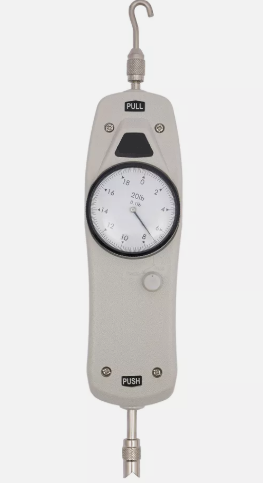
Navigating the complex terrain of ADA bathroom requirements ensures every individual has equal access to washroom facilities, be they a toilet or a urinal. Designers and builders must integrate specific standards for each plumbing fixture to accommodate the needs of all users efficiently. For instance, discernment in the selection and placement of computer hardware within a restroom keeps usability straightforward and compliant. In this article, readers will discover detailed guidelines that demystify the intricacies of ADA lavatory compliance, directly influencing the inclusivity of public restrooms.
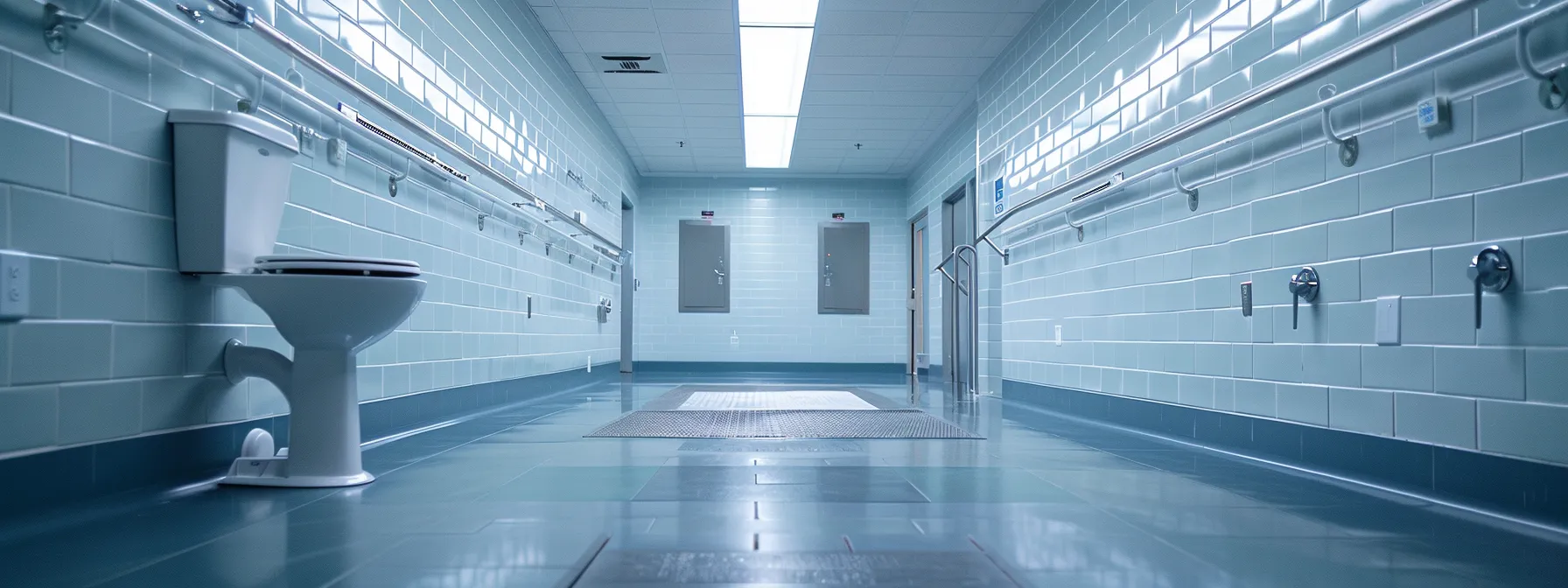
Compliance with the Americans with Disabilities Act (ADA) is not only a social responsibility but also a legal requirement that can mitigate the risk of a lawsuit. Specific regulations that govern the design and construction of lavatories ensure that individuals with disabilities can navigate and use bathroom facilities independently and safely. These ada bathroom requirements regulations include provisions for grab bars, which must be positioned and secured properly to assist users in both residential and public spaces. Lavatories, often an integral part of a bathroom’s countertop, demand meticulous attention to the surrounding clear floor or ground space, enabling unobstructed maneuverability for wheelchairs. This clear space plays a pivotal role in the overall accessibility of the bathroom. Proper knee and toe clearances under the sink are critical for comfort and ease of use, particularly for those in wheelchairs. Standards for the maximum height and reach ranges necessary for a lavatory reflect the commitment to ensuring that individuals can effortlessly access running water. Additionally, faucets and other operable parts must be designed to be easily usable without requiring tight grasping, pinching, or twisting of the wrist. Taking these elements into account protects entities from non-compliance claims and ensures they meet the needs of all users. Contractors and builders must ensure they are well-informed about these standards, which can usually be done by providing a direct email address for inquiries or meticulously reviewing ADA guidelines when planning a new bathroom or remodeling an existing one.
In complying with ADA standards, careful attention to fixtures and hardware within bathroom spaces is paramount. For instance, bathtubs require grab bars in strategic locations to aid in entrance and exit without obstruction, and the toilet paper dispenser’s placement should be within easy reach for a person seated on the toilet. Moreover, sinks must be installed at a height that is accessible from a seated position, with plumbing arranged to avoid interference with knee space, while also ensuring an unencumbered approach and departure route on the bathroom floor.
| Fixture | Requirement | ADA Compliance Goal |
|---|---|---|
| Bathtub | Grab bars for safe entrance and exit | Ensure independence and prevent injury |
| Toilet Paper Dispenser | Placement within reach from a seated position | Facilitate ease of use |
| Sink | Accessible height and knee space | Accommodate use from a wheelchair |
| Floor | Unobstructed route for approach and departure | Optimize maneuverability for wheelchairs |
Residential units must adhere to specific ADA standards to provide accessibility for individuals with disabilities. These regulations stipulate that information regarding the use of each fixture should be clearly communicated, and incorporating braille can enhance accessibility for visually impaired users. To meet ADA compliance, lavatories should offer ample toe clearance to accommodate a seated user, as well as ensuring that the water controls are operable with minimal effort.
The construction of an accessible bathroom warrants the careful layout of clear floor space to create unobstructed aisles for wheelchair users. This essential ADA accessibility consideration ensures that individuals can approach and use the lavatory and related amenities without hindrance, fostering independence and ease of movement. Moreover, the integration of motion sensors to control lighting and fixtures can enhance usability, negating the need for physical contact and reducing barriers to accessibility.
In accordance with regulation, designers must ensure that lavatory spaces permit ease of access, and this is where knee and toe clearances become significant. The space beneath a wall-mounted sink, for example, should be unobstructed to provide sufficient room for the legs of a wheelchair user, while toe clearances ensure that a person can get close enough to reach the towel dispenser or operate the door without contortions.
The message of ADA compliance resonates through every aspect of bathroom design, emphasizing the need for fixtures to be within appropriate reach for individuals who rely on a wheelchair. Ensuring paper dispensers, soap dispensers, and other necessities are positioned within arm’s reach mitigates the challenges that can accompany a disability. Architects and facility managers must prioritize these provisions to safeguard access and autonomy within lavatory environments.
To comply with ADA standards, the installation of fixtures like soap dispensers and paper towel units must account for height and operating mechanisms, allowing use without grasping or straining. Similarly, a hand dryer or any operable part within an accessible toilet area should be positioned for front approach primarily, affording ease of access for all users irrespective of their mobility limitations. The design of these components is more than a matter of practicality; it is a commitment to inclusive design principles, reducing barriers that might limit independence in bathroom utilization.
With a firm grasp on ADA lavatory requirements, architects and designers stand at the threshold of innovation. The next chapter focuses on crafting spaces that both comply with regulations and excel in aesthetic appeal.
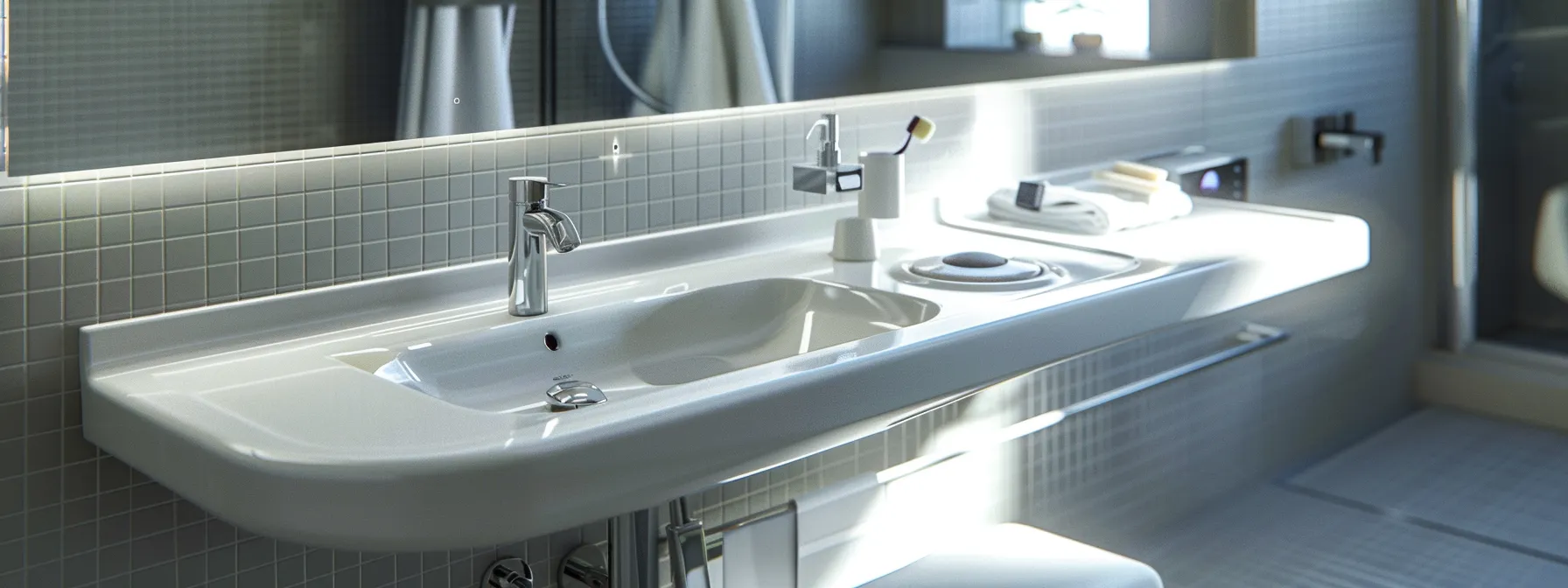
Designers and architects venturing into the realm of public toilets bear the onus of abiding by stringent ADA guidelines, ensuring that lavatories not only facilitate hand washing but embody the full spirit of accessibility. Securing compliance starts with an astute design that places knee space, hand reach, and operational ease at the fore. This calls for an analytical approach to the placement and ergonomics of lavatory components when planning residential dwelling units. A keen focus on creating substantial clear floor space lays the foundation for unimpeded wheelchair mobility, guiding the integration of lavatories into bathrooms. The process extends to choosing faucets and operable parts that consider hand function and independence, evidencing a deep commitment to user-centered design and ADA compliance.
Adhering to ADA standards in the construction of bathroom and kitchen areas extends to the integration of compliant lavatories and sinks, requiring sophisticated software for design planning. The placement of sinks within toilet compartments must allow sufficient space for maneuverability, while installations in kitchens must facilitate access to those who use mobility aids. Marketing these environments, with a focus on inclusion, can enhance brand reputation and demonstrate a commitment to serving all segments of the consumer population.
Designing lavatories for residential dwelling units requires extensive knowledge of building code specifications to ensure accessibility. Elements such as the length of grab bars and the force needed to operate soap dispensers must comply with ADA guidelines to accommodate individuals with disabilities effectively.
| Component | ADA Specification | Goal |
|---|---|---|
| Grab Bars | Required length and placement | Provide support and stability |
| Soap Dispenser | Operating force and reach requirements | Ensure ease of use for all abilities |
| Sink Height | Maximum height from floor | Facilitate access for wheelchair users |
| Faucet Controls | Accessible without grasping | Allow independence in operation |
Designing bathroom spaces to meet ADA requirements incorporates creating clear floor or ground space, which is essential for individuals using wheelchairs or other mobility aids. Ensuring that the height of sinks and showers allows for unimpeded access fosters independence in activities such as hand washing or bathing. Additionally, thoughtful placement of toilet bowls and toilet seats, along with easy-to-use lever controls, contributes to an environment that respects the autonomy of users with disabilities.
| ADA Element | Requirement | Significance |
|---|---|---|
| Sink Height | Accessible height for wheelchairs | Ensures sink use without assistance |
| Shower Accessibility | Height and controls suitable for all users | Facilitates independent shower use |
| Clear Floor Space | Ample space for wheelchair maneuverability | Allows unhindered navigation in the bathroom |
| Toilet Bowl and Seat | Designed for ease of transfer from a wheelchair | Aids in maintaining user dignity and safety |
| Lever Controls | Easy to operate without grasping | Supports users with limited hand mobility |
Designing accessible bathrooms in compliance with the United States Access Board guidelines necessitates careful consideration of knee and toe clearances to enhance usability. A mirror or any other fixture within the bathroom must be positioned so that all users, irrespective of their posture or mobility, can utilize them without strain. For example, a coupon dispenser placed at an accessible height can offer convenience without compromising accessibility.
To ensure ADA compliance, the selection of faucets and other operable parts in a lavatory must prioritize dimensions that accommodate all users, including those with limited wrist mobility. An operable part should hence not require more than five pounds of force to activate and should be operable with a simple push, pull, or one-handed motion, according to international building code standards. For example, faucet handles should not necessitate tight grasping or twisting of the wrist and must be placed within a user’s reach, typically no higher than 48 inches, which is clarified in detail within ADA guidelines available in PDF format.
| Operable Part | Force Requirement | Reach Limit | User Mobility Consideration |
|---|---|---|---|
| Faucet Handle | No more than 5 pounds | No higher than 48 inches | Limited wrist mobility |
Moving from thoughtfully crafted sinks to the area surrounding them, attention shifts to the ground level. The design of clear floor space at lavatories takes center stage, governed by meticulous ADA guidelines.
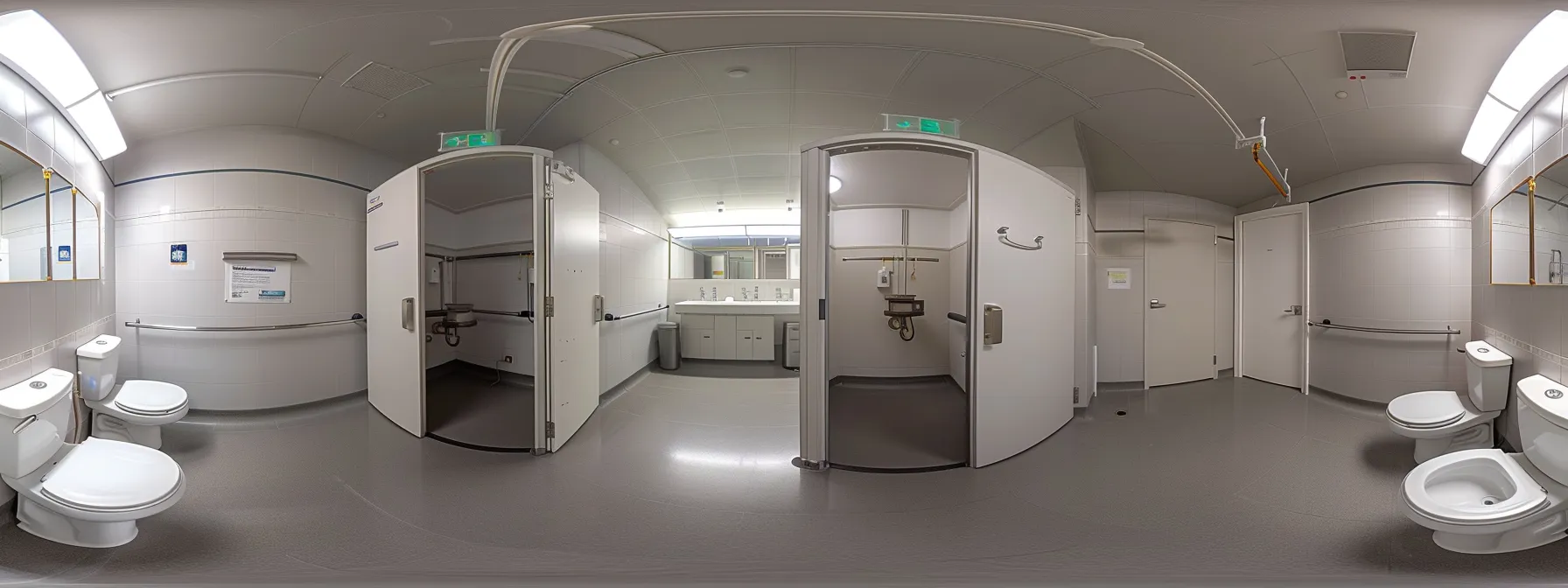
Fulfilling the American Disabilities Act lavatory specifications begins with a thorough grasp of clear floor space dimensions, a pivotal aspect that can make or break the usability of a restroom for individuals with disabilities. An adequate amount of room serves as the foundation for an accessible environment, enabling ease of movement and safe navigation. Recognizing the significance of space in lavatory design is critical, as it impacts the user’s experience, allowing for unassisted and dignified use of the facilities. Designers must employ creative solutions to amplify the available space within confined bathroom layouts, guaranteeing that accessibility remains uncompromised. Practical tips and thoughtful consideration of spatial constraints will assist in maximizing clear floor space, even in smaller restrooms, ensuring a functional and compliant outcome for all users.
The clear floor space at lavatories serves to provide unobstructed access and is governed by precise dimensions as outlined in ADA regulations. For a lavatory to be deemed accessible, the clear floor space must measure at least 30 inches by 48 inches, allowing individuals using wheelchairs ample room to approach and utilize the sink and its components comfortably.
The design of an accessible bathroom hinges on the clear floor space provided around lavatories, which is essential for the maneuverability of wheelchair users. This area allows for forward or parallel approach by individuals with disabilities, facilitating unencumbered access to sinks, soap dispensers, and dryers, and thus fosters independence in personal hygiene tasks.
Designers facing the challenge of small bathroom spaces can optimize the available area through the use of wall-mounted sinks and fixtures, which free up floor space and support clear circulation paths for wheelchair users. Employing sliding doors or pocket doors instead of traditional swinging ones can also substantially increase accessible space and ease of entry and exit.
Understanding ADA guidelines is just the beginning; ensuring proper knee and toe clearance is the next critical step for lavatory accessibility. Let’s examine how to create spaces that not only meet but exceed these accessibility standards.
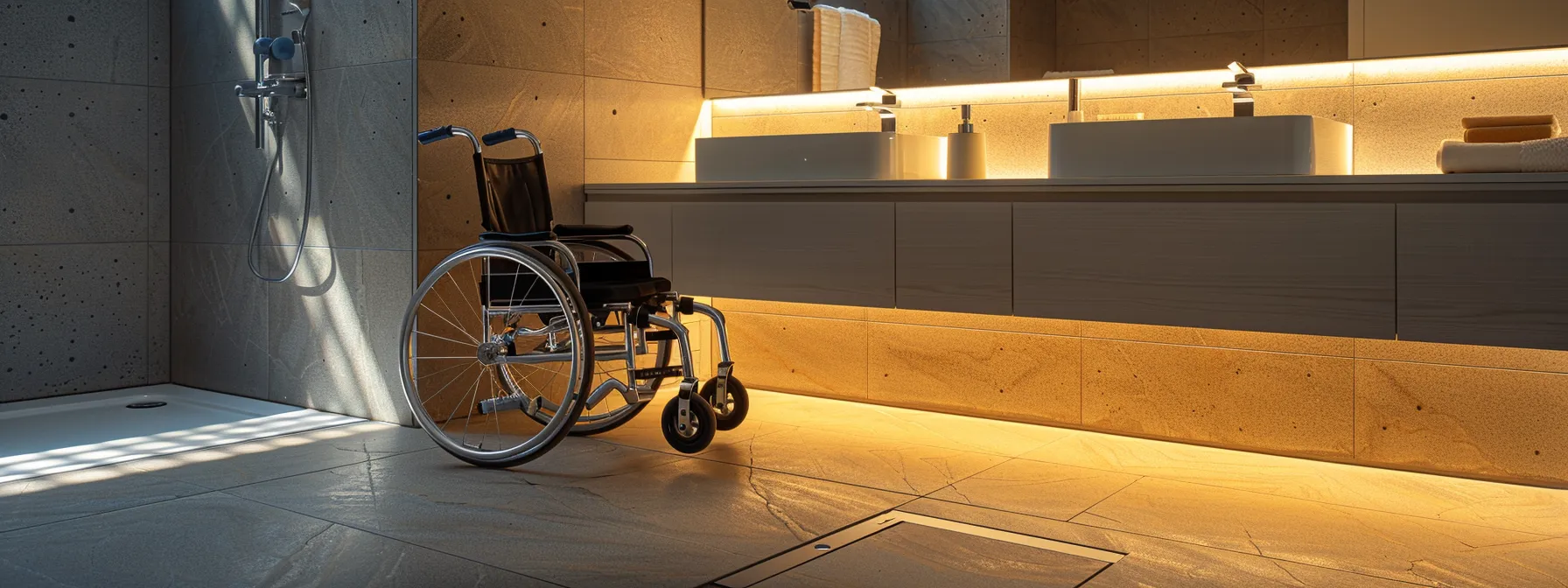
Designing an ADA-compliant bathroom entails careful planning to cater to the needs of individuals with mobility impairments. The area beneath a sink is often overlooked, yet it is imperative to provide adequate knee and toe clearances to ensure comfort and functionality for wheelchair users. These clearances are defined by minimum measurements that must be maintained to permit forward approach and use of the lavatory. Architects and designers employ various strategies to enhance these spatial provisions, integrating innovative fixtures and creative design layouts that not only meet but exceed compliance standards. On the other hand, oversight in this aspect of design could inadvertently introduce obstacles, making facilities less accessible. Recognizing common design errors is crucial to avoid such pitfalls, ultimately leading to a more welcoming and usable bathroom environment for all individuals.
Adherence to established knee and toe clearances in bathroom design is mandated to align with ADA standards. Sinks must have a knee clearance of at least 27 inches high, 30 inches wide, and 19 inches deep, while toe clearance requires a minimum height of 9 inches and must extend at least 17 inches deep.
Design professionals are increasingly utilizing adjustable-height sinks to meet ADA criteria for wheelchair users, as these innovative fixtures can be tailored to individual needs, thereby enhancing the knee and toe clearances. Meanwhile, open-under sink designs are gaining popularity, as they remove potential barriers beneath the sink, providing a straightforward solution to meet clearance requirements while simplifying the aesthetic of the space.
Architects and designers sometimes neglect the required dimensions for knee and toe clearance, leading to lavatories that are difficult to access for those in wheelchairs. Another common error involves the improper placement of pipes which can restrict the necessary under-sink clearances and become a safety hazard for users. Ensuring these oversights are addressed during the planning stage is vital to create accessible and compliant bathroom spaces.
Having addressed the nuances of providing ample knee and toe clearance, the narrative now shifts to the critical aspect of faucet and operational component accessibility. This essential step strengthens universal design, ensuring that ease of use is at the forefront of accessible lavatory configurations.

In the quest to construct lavatories that are universally accessible, the careful selection and installation of faucets and operable parts hold significant weight. These components must comply with ADA guidelines, which dictate that handles, valves, and other controls should operate effortlessly and without the need for tight grasping or twisting – a vital consideration for individuals with limited dexterity. Designers and builders grapple with decisions about which faucets meet these stringent requirements while also addressing the practicalities of day-to-day use. Beyond choosing compliant products, installing them in a manner that aids accessibility is just as imperative. Addressing common challenges such as limited reach, operational force, and clearances under sinks contribute to a lavatory that is safe and convenient for all users. This introspective dive into the intricacies of faucet and hardware selection and placement is an important stride towards achieving an inclusive, well-equipped bathroom environment.
When selecting faucets and operable parts for ADA-compliant lavatories, design professionals prioritize products that require no more than five pounds of force to activate and do not demand tight clutching, pinching, or twisting of the wrist:
| Product Type | Activation Force | Operation Method |
|---|---|---|
| Faucets | Maximum 5 pounds of force | Push, pull, or one-handed action |
| Soap Dispensers | Maximum 5 pounds of force | Push-button or automatic sensors |
| Flush Controls | Maximum 5 pounds of force | Lever-operated or touchless mechanisms |
Professionals engaged in the installation of operable parts must anchor fixtures at heights reachable from a seated position, often not exceeding 48 inches from the floor, to accommodate individuals in wheelchairs. The placement should facilitate a forward or side reach, ensuring users can access controls with minimal strain. Meticulous alignment during installation can vastly improve the usability and accessibility of lavatory spaces for individuals with disabilities.
To mitigate common accessibility challenges in lavatories, professionals integrate fixtures designed for ease of use, such as faucets with sensor-based controls, eliminating the need for manual operation:
| Challenge | Solution | Benefit |
|---|---|---|
| Limited Manual Dexterity | Sensor-based Faucets | Eliminates need for grip or turn |
| Restricted Reach | Frontal Approach Designs | Access without extensive movement |
| Operation Difficulty | Lever and Touchless Controls | Simple activation for all users |
Including lever handles or touchless controls for flush mechanisms not only streamlines operation but also serves a hygienic purpose, minimizing contact points and subsequently reducing the transmission of pathogens.
Transitioning from accessible faucetry, attention must now shift to garbage disposals. Adherence to ADA standards for these installations ensures inclusivity at the sink.
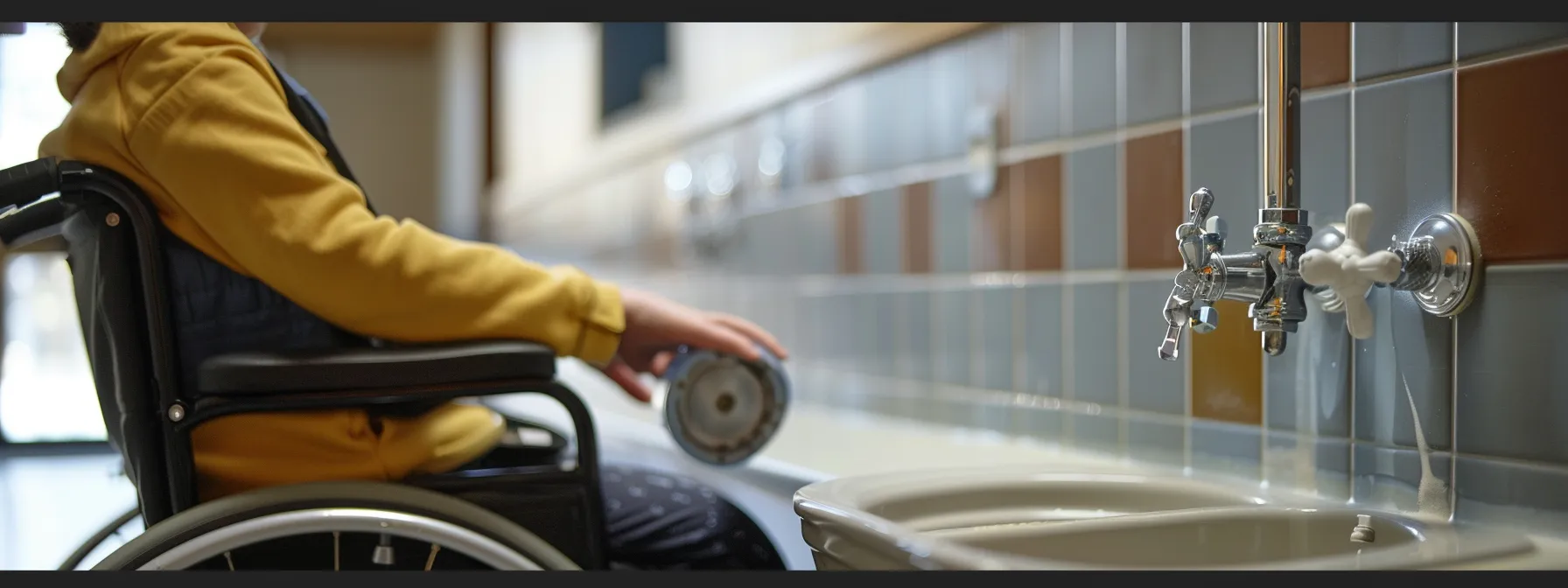
Ensuring that every aspect of a bathroom meets ADA standards includes addressing the incorporation of garbage disposals within sinks. As a functional element often found in residential and commercial settings, garbage disposals must align with accessibility requirements without compromising the usability of the sink for individuals with disabilities. This includes considering the height at which a garbage disposal switch is mounted, the required clearance underneath the sink for the appliance, and the force needed to operate the switch. Successful integration of garbage disposals into ADA-compliant sinks mandates careful analysis and strategic alterations in design, guaranteeing that accessibility is uninterrupted and the convenience afforded by such appliances is available to all users.
Incorporating garbage disposals into ADA-compliant sinks demands careful consideration of operability and clearance:
Accommodating garbage disposals within ADA-compliant sink designs necessitates a focus on maintaining the requisite clearances for accessibility. Design modifications can include deeper sink bases to house the disposal mechanism while preserving essential knee and toe space, or opting for compact disposal units that integrate seamlessly without impinging on the necessary under-sink area.
Maintaining an uninterrupted accessibility flow, while accommodating garbage disposals under sinks, requires designers to select apertures and switches that users with disabilities can operate with ease, while avoiding any encroachment on allocated knee and toe space. By ensuring that disposal controls are accessible and easy to engage from a forward position, designers help preserve the continuity of an ADA-compliant bathroom‘s inclusivity and functionality.
Adhering to ADA lavatory requirements is crucial to ensure that bathrooms are accessible to individuals with disabilities, providing them with independence and safety. Thoughtful design concerning knee and toe clearances, as well as the placement of fixtures and operable parts, empowers all users with ease of access. Failing to meet these standards not only leads to non-compliance but also creates barriers that exclude a significant portion of the population. Ultimately, compliance with ADA guidelines in bathroom construction reflects a commitment to inclusivity and acknowledges the right of every individual to navigate public spaces with dignity.



Measuring door pressure is acting in compliance with building regulations, like the Americans with Disabilities Act (ADA). It’s an important step in ensuring accessibility, safety

When talking about building safety, the first things that come to mind are fire alarms, emergency exits and security systems. Meanwhile, the one tool that